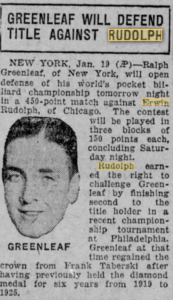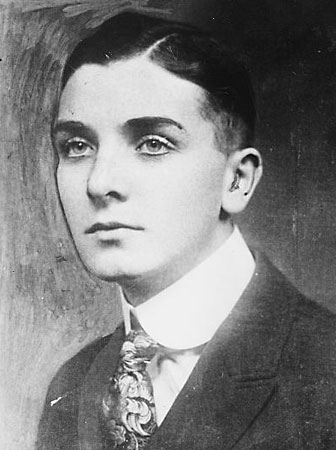
In January, 1927, two of America’s best players — Ohio’s Erwin Rudolph and Chicago’s Ralph Greenleaf—met in New York City to determine who would become pocket billiards next champion. Greenleaf had held the title uninterrupted for seven years running, relinquished it in 1925 to Frank Taberski, and then quickly regained the crown the following year in Philadelphia. It was in that 1926 tournament that Erwin Rudolph placed second, his highest finish to date. Under the rules then enforced by the sport’s sanctioning body, Rudolph gained with his runner-up status the right to challenge Greenleaf in a one-on-one dual for the title.
And hence, New York City, Jan. 19, 1927: a three-day, three-block match for the world title. On one side Ralph Greenleaf, the hard-living young champion. On the other Erwin Rudolph, the clean-cut, obnoxiously non-drinking challenger. Greenleaf was 25. Rudolph a few years older. The contestants would play at the spacious Dwyer’s Billiard Academy, 39 John Street, playing to 450. The game, as usual, was straight pool. Erwin Rudolph went into the match as an under-dog but not as a push-over. As one reporter noted: “Rudolph is one of the most confident players in the pocket billiard game today and with the exception of the champion, Greenleaf, he is said to have no equal at the present time.”
Beginning Doesn’t Go as Expected
Greenleaf’s title defense did not begin as expected. On the first night he clearly was off his game — “off color,” as some commentators euphemistically describe it — and he fell behind quickly. The ventilators were either broken or tampered with, raising the packed room’s temperature, despite the season. Rudolph, a bald man and slender — not handsome like Greenleaf — at one point led by 43. Greenleaf answered with a spirited defense, sinking 43 balls consecutively and eventually evening the tally. But it wasn’t enough and with a flourishing run of 27 he ended Greenleaf’s night. The final score after 25 innings: 158 or Rudolph; 146 for Greenleaf. “All the people who have said that Rudolph did not have a chance are preparing their alibis in advance,” wrote one commentator.

On the second night, however, Greenleaf started hot and stayed hot. He attacked the table from all sides, firing off long-range straight ins or cut shots, but always with the cue ball settling back precisely into position. The young lion took the second block 161 to 122, bringing the tally to 307 to 280 in his favor.
But 1927 was not to be Greenleaf’s year. Erwin Rudolph came from behind to take the third and final block, and he did so in grand fashion, pocketing more than two balls to every single ball pocketed by Greenleaf. Final score: 450-384. The defeat made headlines from coast-to-coast. Somehow Greenleaf, the greatest player of the age, had been bested.

Recent Comments